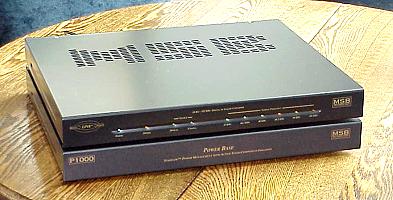Product Review - MSB Technology
Link DAC III Digital-to-Analog Converter - April, 2000
John E. Johnson, Jr.
![]()
|
MSB Technology Link DAC III 24 Bit - 96 kHz Burr Brown Stereo DAC Toslink Optical and RCA Unbalanced Digital Inputs RCA Unbalanced Analog Outputs, Analog Pass-Through RCA Jacks also included Size: 2" H x 17" W x 14" D Weight: 11 Pounds MSRP: $399 USA |
| MSB Technology Corporation, 14251 Pescadero Road, La Honda, California 94020; Phone 650-747-0400; Fax 650-747-0405; E-Mail [email protected]; Web http://www.msbtech.com |
Introduction
We often receive questions about whether or not a 24/96 DAC can improve the sound of 16 bit CDs. So, now that high-performance 24/96 outboard DACs are available, I decided to try one out. MSB Technology has been upgrading surround sound processors and receivers to handle Dolby Digital and DTS signals for years, and perhaps they are best known for that service. However, they also make other products, including outboard DACs. The Link DAC III is their latest product in that line. The basic unit retails for $399, which includes 96/24 DAC chips, and it is powered by a "wall wart". Although most of us probably hate wall warts, they do one thing very well, namely keeping 120 V AC away from the main component. The P1000 Power Base goes a lot further, as it is a heavy power supply all in itself, with a toroidal transformer, power supply capacitors, and other heavy duty parts. It sells for $299 and is exactly the same horizontal size as the Link DAC III, so the DAC sits on top of it. The two together (MSB supplied both for review) weigh in heftily at 22 pounds. That is a lot for just doing digital-to-analog conversion. A good part of that weight is, of course, the chassis rather than capacitors and resistors, but nevertheless, heavy is good.
Options
There are some other upgrades -
perhaps we should just call them options - for the Link DAC III. One is HDCD
capability ($199), and a second is upsampling 16/44.1 to 24/96 ($199).
Upsampling and Oversampling can get confused with one another, because
upsampling is a subset of oversampling. In both cases you end up with more
data, i.e., more samples. Using mathematical computation, the original samples
are "examined" and more samples are created in between the original
ones. They might just be strings of 0s in some situations, but in any case,
the process allows the DAC to do its job more easily. Upsampling in the Link
DAC III is accomplished in a chip outside the DAC chip itself, while
the oversampling is done inside the DAC chip. So, when the upsampling
is engaged (a toggle on the back of the Link DAC III lets you turn on or turn
off the upsampling), incoming 16/44.1 data are upsampled to 24/96. Then, the
24/96 data are fed into the DAC, where oversampling occurs. As far as the DAC
chips are concerned, the incoming data are native 24/96 signals. Upsampling is
for the purpose of actually creating more data, and the new data are computer
representations of what the upsampling chip has interpolated from the native
data. Oversampling is just for reducing noise and allowing the
filters to more easily remove frequencies above 22 kHz so that you don't get
"aliasing", which are false frequencies created from having too few
samples. 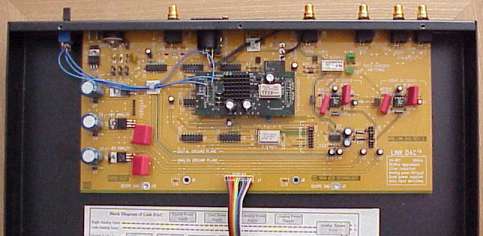 In both cases though, the new digital information is computer
generated as "best guesses".
In both cases though, the new digital information is computer
generated as "best guesses".
In the final analysis, after all the hype, we should ask the question, "Does it work, and do I like the sound?" As you will see, upsampling does appear to improve the sound. However, true native 24/96 data, where the 24/96 samples are created in the analog-to-digital converter at the time of recording, will be better than anything the computer chips can come up with in estimating 24/96 from 16/44.1 samples, at least with known current technology. True 24/96 CDs and DVDs are just now becoming available, but what about all those millions of 16/44.1 CDs that are out there? Upsampling is the best that can be achieved. The unit we received had the 24/96 upsampling chip installed, and there was also an additional upsampling chip included in a separate box for us to experiment with, which upsamples to 24/132.
The inside of the Link DAC III is mostly empty space. This allows for better cooling and also to fit the standard size of most other components that might be on your equipment rack. The PC board sits at the rear (see photo above). In the center of the PC board is another, smaller, board where all the action occurs. The multicolored cable at the bottom of the photo supplies voltage to the indicator LEDs on the front panel. The front panel LEDs indicate power on (there is no on/off switch), Toslink or Coaxial digital input, and the sampling frequency being decoded (32 kHz, 44.1 kHz, 48 kHz, 88.2 kHz, 96 kHz). If the high speed upsampling chip is installed, the frequency LED does not light when upsampling is switched in). There is a 192 kHz LED for when that option becomes available.
The rear panel of the Link DAC III sitting on top of the P1000 Power Base is shown in the photo below. Starting from the left are a pair of coaxial analog inputs (for pass through), a pair of coaxial analog outputs, an XLR balanced digital input (this replaces the Toslink input when the Nelson upgrade is installed), a coaxial digital input, the connection between the P1000 Power Base and the Link DAC III, and a toggle for switching options in and out of the circuit. At the bottom right corner of the P1000 is the grounded AC socket for a detachable power cord.
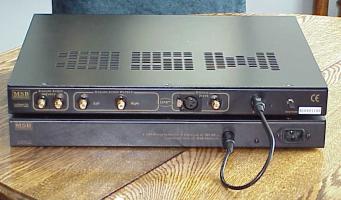 |
The inside of the P1000 Power Base (photo below) is just as Spartan as the Link DAC III. The toroidal transformer is in the center, and the PC board, shown close-up on the right, is at the rear of the chassis. The advantage of the larger power supply is that filtering is superior to the wall wart, and this will reduce jitter.
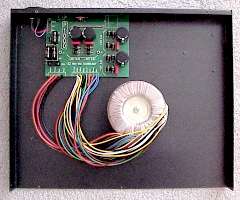 |
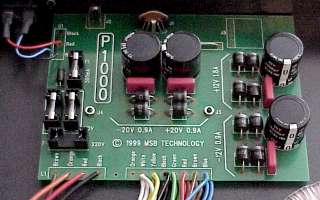 |
Close-ups of the Link DAC III PC board are shown below. In the left photo can be seen the DAC portion, covered by a heat sink, next to which is the factory installed 24/96 upsampling chip (labeled FOX). In the right photo, the 24/132 high speed upsampling chip is shown, after I installed it (labeled CARDINAL).
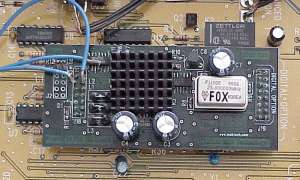 |
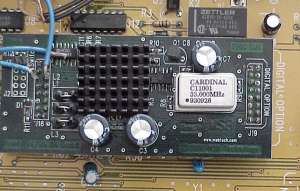 |
In order to install the 24/132 upsampling chip, I removed the original upsampling chip with my thumb and fingers, and then I followed the procedure shown in the three photos below. (1) I aligned the new chip's pins with two of the sockets (below, left). Make sure the label of the Cardinal chip is facing the same way that the original Fox chip was facing, i.e., not upside down. (2) I rocked the chip forward until the other two pins went into their sockets (below, middle), and then, (3) I pushed the chip down so that it was secure in position (below, right). Obviously, you should do this procedure gently.
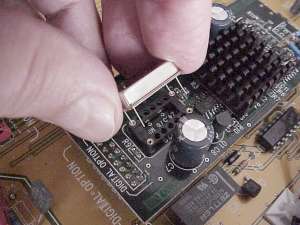 |
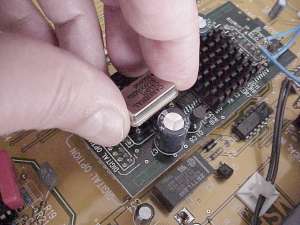 |
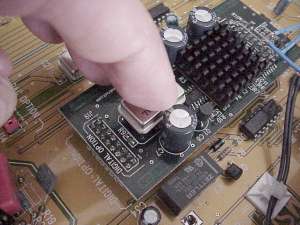 |
One other option is called the Nelson Upgrade, after someone named Nelson at MSB. It upgrades the capacitors and resistors to higher quality ones, replaces the Toslink input with a balanced XLR input, and also increases the rail voltage in order to allow more dynamic range at the outputs. This option is $485. So, the setup we reviewed included the basic unit, with upsampling, with the Nelson upgrade, and the P1000 Power Base. This package retails for $1382, which is no chump change. But, remember, the DAC is a critical part of the signal chain. Preamplifiers and power amplifiers will only amplify whatever signal is presented to them, good or bad.
The Sound
I tested the MSB package with a McCormack CD transport, Balanced Audio Technology VK5i tube preamplifier, Balanced Audio Technology VK-500 solid state power amplifiers, Threshold electrostatic speakers, Osborn Eclipse speakers, and Carver Amazing Mark IV ribbon speakers. Cables were Nordost.
The toggle on the back of the Link DAC is very handy, because it lets you switch an option in or out of the circuit. Even with the upsampling out of the circuit, I could hear a distinct improvement in the clarity of the sound, compared to my older McCormack DAC that has 18 bit chips in it. However, the McCormack does has upgraded parts in it, like the Link DAC, so I feel the improvement is due to the 24/96 capability of the Link DAC rather than any difference in part quality. When I switched in the upsampling, the midrange seemed to bloom, to become fuller, and I liked this very much. I could hear no marked difference between the factory upsampling chip and the experimental one, but I left the experimental one in for the rest of the review process. A future upgrade for this DAC is the ability to decode native 24/192, such as in some DVD-Audio discs. I suppose that 24/192 upsampling from lower sampling formats will also become available. Upgradability is an extremely important feature when shelling out big bucks. Replacing the chips seemed a very easy task with this unit. The only other thing I might suggest adding is a set of balanced XLR analog outputs for the various fully balanced preamplifiers that are now available.
I brought my daughter and her friend (both aged 26) in to listen to music, while I did an A/B switching between upsampling and no-upsampling. I did not tell them which was which, or even what I was testing. They both preferred the no-upsampling position, saying that the sound was "sharper". Now, I suppose that a fuller midrange, interpreted by me in the upsampling position, could be the same thing as a sharper high end, interpreted by these young listeners, in the no-upsampling position, when we take into account my reduced hearing above 12 kHz. Regardless, this points out the importance of having the option to turn the upsampling on or turn it off, depending on the user's preferences. The high-speed upsampling chip makes the DAC run hotter, much like overclocking does to the microprocessor in your computer. This, again, is an advantage of having so much empty space in the chassis.
It did not matter what type of music I played, classical, pop, jazz, etc. The Link DAC III made a noticeable improvement with all of them. Detail was there that I had missed for a long time. I thought my hearing was getting old, but no, it was just time for a 24/96 DAC. The nice thing is that you don't have to get all the options at once. I would suggest having the Nelson upgrade when you purchase it, assuming you don't need Toslink (if you need Toslink, subtract $100 for the Nelson upgrade without the addition of an XLR input), but the P1000 and upsampling options are user installable anytime you want at a later date.
- John E. Johnson, Jr. -
![]()
� Copyright 2000 Secrets of Home Theater & High Fidelity
Return to Table of Contents for this Issue.

